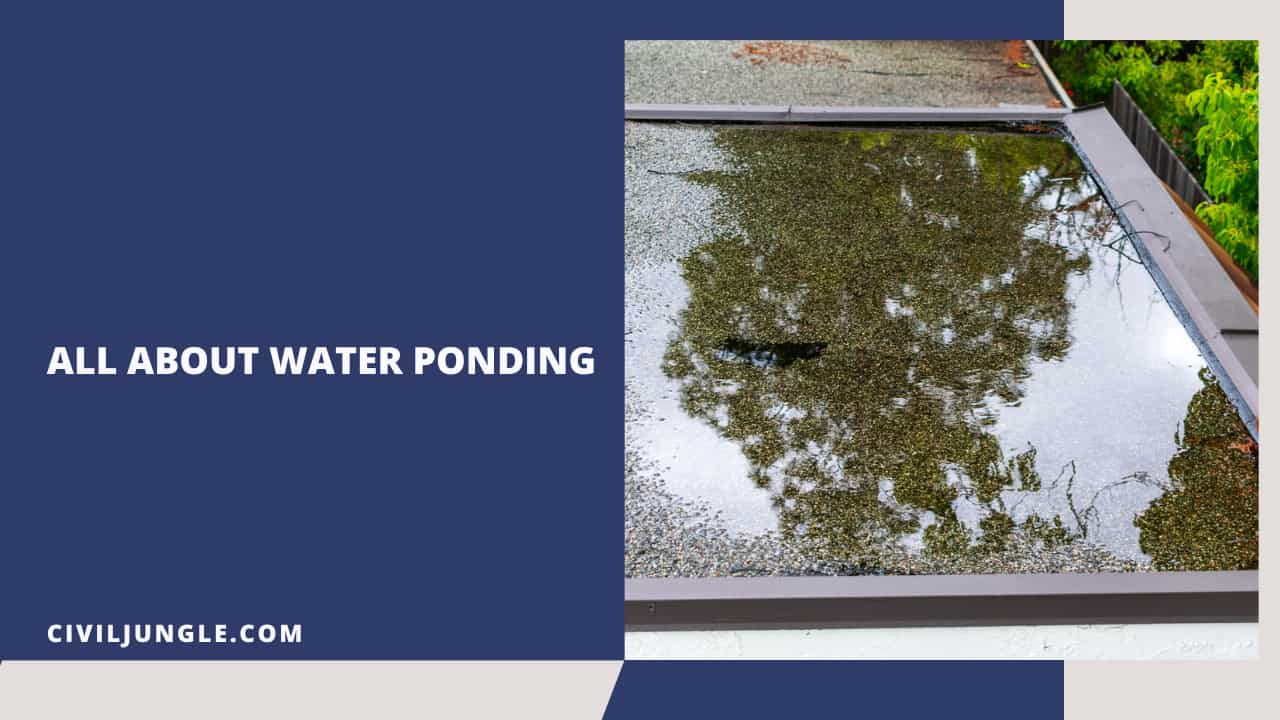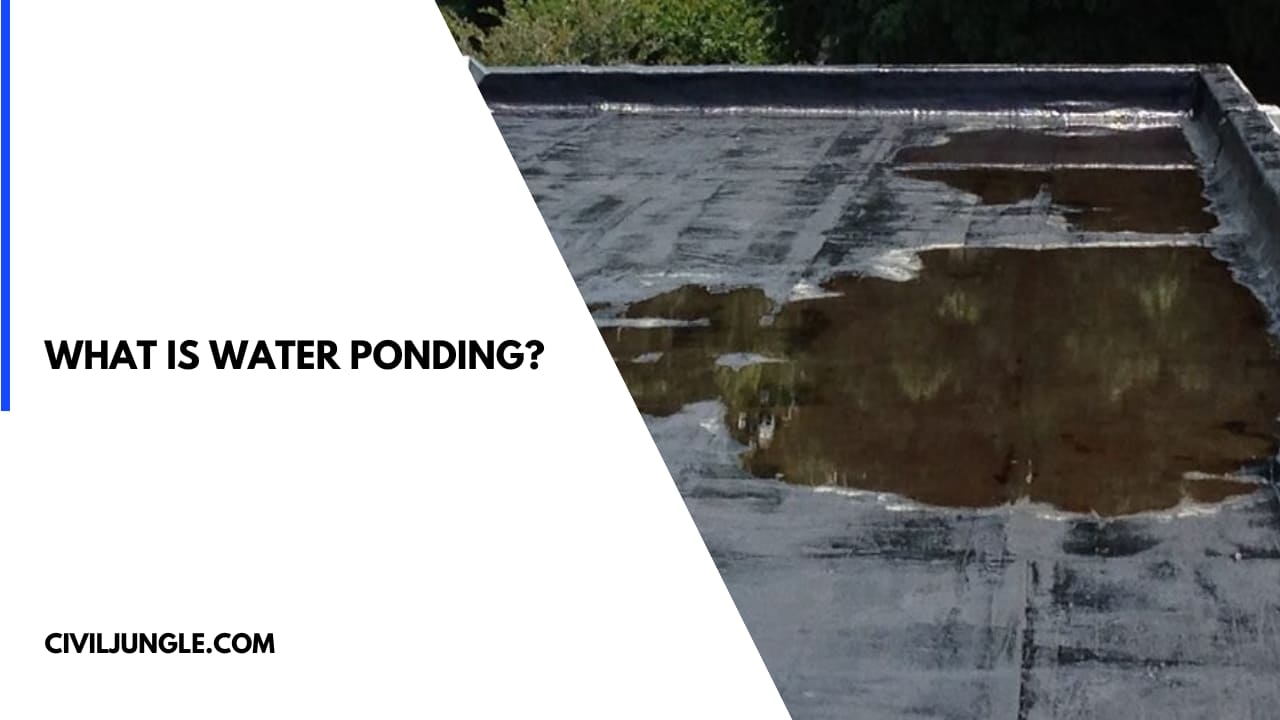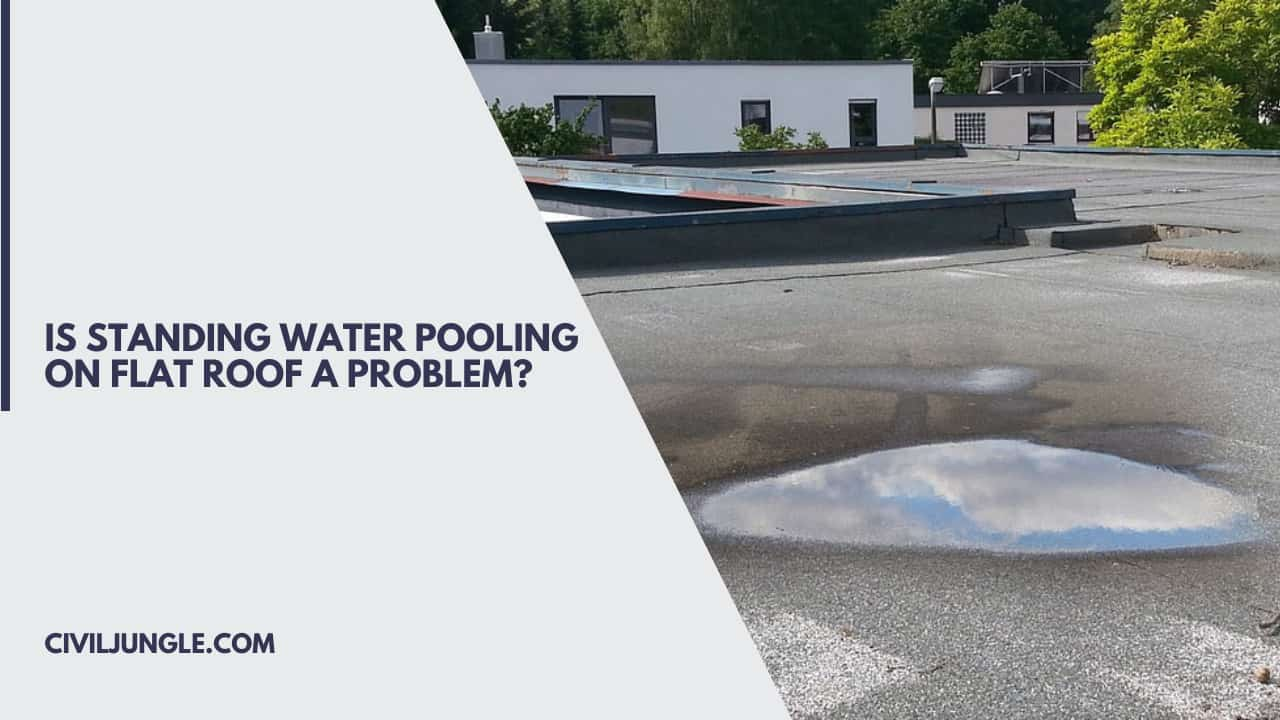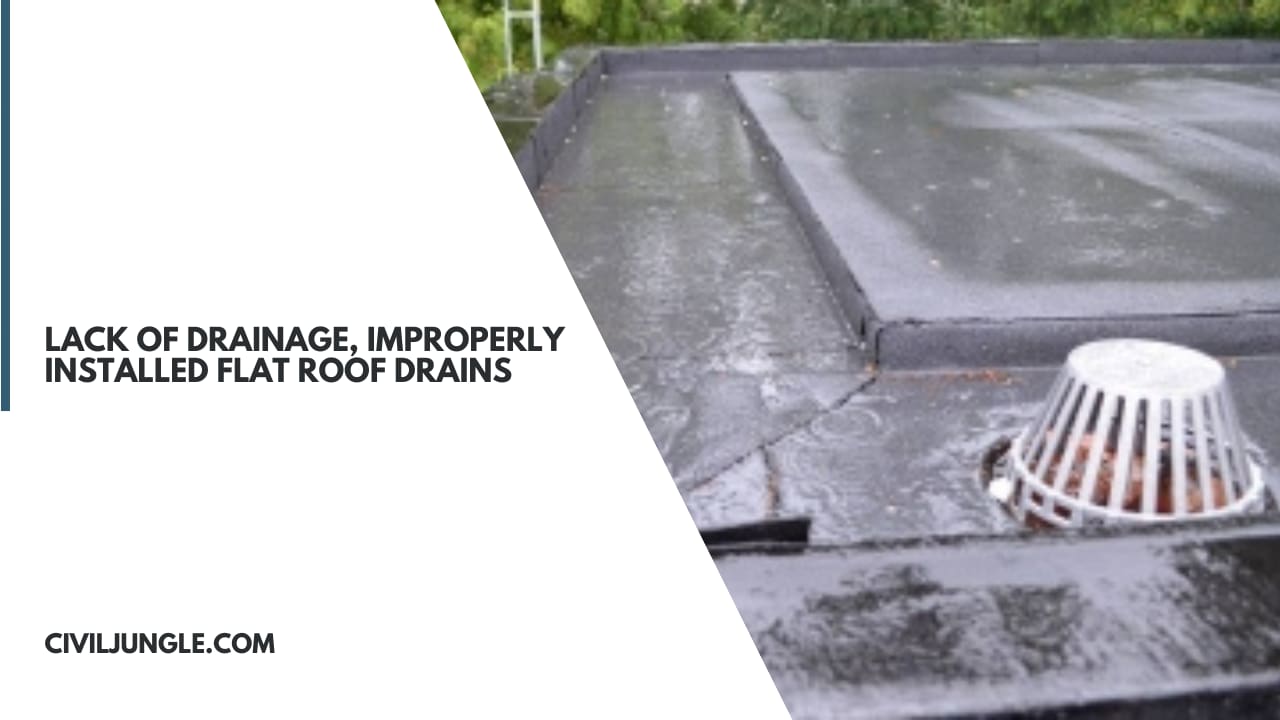
What Is Water Ponding?

As in Construction Industry, National Roofing Contractors Association(NRCA) described water ponding meaning as “Water which remains over the roof surface for more than 48 hours, after the termination of recent rain event.
So in simple words, Water Ponding can be explained as a major accumulation of water over the flat roof, which can be caused due by various reasons, can result in a major drawback with proceeding time.
Is Standing Water Pooling on Flat Roof a Problem?

From ancient civilization, people tend to shelter themselves from natural calamities, such as rain, thunderstorm, cyclone, and many others. At first, they accommodated themselves using caves built by rock.
Slowly with time, we grew aesthetic sense, which helped us to improve our living quality as well. Thus caves of rock became transformed into huts, which also transformed into houses with concrete roofs.
As per the research papers of many designers, and also as per National Building Code, Roofs can be of different types, selection of which depends upon, type of house, architectural consideration, and primarily, the weather or climate of the particular topographic area.
As the climate differs, the selection of the type of roof also defers, such as, in heavy rainfall or snowfall region, Sloping or pitched roof may be considered(having a slope of the roof more than 10°, is called high slope-pitch roof), to drain the water constantly thus preventing any stipulation of water over the roof.
In the case of a flat roof, the slope of the roof is far below 10° which can be used topographic area having low to medium range rainfall.
This type of roof is very easy to construct and also have a pleasant look, this type of roof is widely adopted in moderate climatic condition, which prevails around eight months in most of the places in India.
Although it has its reasons, as rainfall occurs mostly in monsoon time, one big question still prevails, “does water logging occurs on flat roofs? Can this be considered a problem?”; to answer this, some basic knowledge on waterlogging needs to be gathered as follows-
Common Causes & Solutions for Ponding Water

1. Water Ponding: Causes
As already mentioned earlier, Flat roofs have a slope very less than 10°(or very precisely to say, less than 2°).
Thus to drain the water stored at the top of the roof surface, due to rain, mostly gutters, internal drains, or Rain Water Pipes(RWP-having a common diameter of 100mm) are installed at the edges of the roof.
The number and location of fixing of the rainwater pipe are generally determined by design, as well as the layout that can provide the most effective type of drainage.
effective maybe due to the designer’s lack of capability, or due to the sudden change of climate, this can be proved ineffective. Thus as a failure of the function of the rainwater pipe, the water remains logged in the roof for a long time, resulting in water bonding.
Water ponding can also be witnessed at roads, having inadequate design drainage, logged the into the surface after a severe rain, which can fail in the roads.
In our modern civilization, many high-rise buildings can be witnessed. As the intensity of rain is very high and concentrated at buildings having more height, many a time, this becomes a major factor in water bonding.
2. Water Ponding: Effect
The effect of water ponding can be very dangerous if left untreated. Whenever water is accumulated at the top of the roof, slowly with time, it dampens that particular portion of the roof, as well as its surroundings, due to the capillary flow of water.
Starting with roofs, the capillary action of water in the walls can also be shown, resulting in peeling and discoloration of paints as well as plaster, resulting in the dampness of the wall as well.
Thus to rectify this, one needs to treat the roof using waterproofing chemicals and refurbish the walls as well, which can be very much costly.
Accumulation of Insects, such as fungus, moss can be found growing in the walls due to the capillary action of rainwater. Thus one needs to adopt anti-fungal treatment for roof and wall as this adds to the expense.
3. Water Ponding: Prevention
To prevent water bonding at the top of the roof surface, drainage design should be done accurately by experienced designers and checked thoroughly to rectify any unwanted mistakes.
The number and the location of the rainwater pipes, gutters, stormwater drains to be accurately determined depending upon the exact pitch of the roof; so that water gets drained out immediately after dropping at the roof surface.
Many a time, some waterproofing treatment is done after the construction of the roof. This protects the roof from any adverse effect of waterlogging and also increases the longevity of the roof. It’s not too very expensive, but adopting it can yield very good results for the roof.
Rubber Roofs with Multiple Layers For Water Pounding

Apart from Asphalt roofing, another widely adopted roofing system for flat or low slope-pitch roofs is membrane roofing.
In this type of roofing, the primary material adopted is a membrane, which is generally polymer-based materials, which is why this type of roofing is denoted as “Rubber Roofing” as well.
Some materials used for manufacturing membranes are, Neoprene, PVC(Polyvinyl Chloride), EPDM, Polymer modified bitumen, etc. It is very much similar to Asphalt Roof, where it is applied in large sheets over the roofs, to resist the permeation of water.
In the case of this type of roof, generally, 2-3 layers of the membrane are implemented as this will give more resistance to water ponding as compared to the application of a single layer of the membrane.
One of the biggest advantages of membrane roofing is that it is very cost-effective and installation cost is also low as well. Thus incur such a roofing system will not incur much money, in return, it’ll provide longevity to the roof. The age of this type of roofing system can vary from 20 years to 35 years.
Importance of Roofing Material For Water Ponding

Thus from the above, The importance of roofing material can be pointed out as-
The roofing material protects the roof from the adverse effects of heavy rainfall, snowfall, thus increasing the durability of the roof as a whole, Roofing materials protect the roof in case a fire breaks out, which guards the roof against being damaged.
A wood shingle roof can be molded into any shape thus increasing the aesthetic appearance of the roof to the tenants. Many a time, roofing materials dissipate the heat which often gets absorbed by the bare roof.
Thus roofing material is indirectly responsible for a cool and pleasant atmosphere on the inside, while extreme temperature avails on the outside.
Quality Vs Craftsmanship
What is Quality in Roof Material For Water Ponding?: In one sentence, Quality is an integral property of an individual material, which ensures that material is sound, durable, structurally stable, and can suitably used for the function as per its technical specification.
What is Craftsmanship in Roof Material For Water Ponding?: Craftsmanship is the procedure of erecting something, with a creative solution, so that it can give a very pleasant look as per the owners or clients’ requirements.
The terms quality and craftsmanship are very much related and craftsmanship is the procedure of beautifully erecting something, and quality is the way of ensuring its structural integrity…
In many of the roofing systems, such as wood shingle roofs, the craftsmanship involved is very high. One needs to require high skills to mold the woods in a desirable shape and to give beauty to the roof as per the owner’s requirement.
On the other hand, one needs to ensure the quality of the wood, the structural design, the dead & live loads applied on the roof, should also be taken into consideration.
Achieving high quality requires, a better quality of woods are used, which also, in turn, affects the craftsmanship as a whole. Thus Quality and craftsmanship are completely interdependent.
The quality of the material has to be checked before starting the work. When the quality is ensured, only then craftsmanship starts the work. Thus for craftsmen, quality is a pre-inspection procedure, while for quality, craftsmanship is the actual product.
Lack of Drainage, Improperly Installed Flat Roof Drains

As already mentioned earlier, design is the primary factor on which the whole water bonding factor depends. Whenever there is the unavailability of proper design, the numbers and locations of rainwater pipes and pipe puddles become inadequate as per the drainage.
Thus, a lack of drainage occurs. Improperly installed flat roof drains can also be a factor driving the lack of drainage. To prevent that, the design should be made correctly and checked thoroughly.
In case of inadequate design, many a time protective courses (maybe a layer of screed concrete) are provided over the roof along with a corrected design to properly drain rainwater. In that case, no other protective or waterproofing roofing material should not need to be implemented.
Crushed Insulation Causing Uneven Roof Slopes
As in the case of modern houses, mostly concealed conduit wiring is being adopted. In that case, many a time, it happens that the insulation below the roof level becomes crushed due to high live load over the flat roof surface.
In that case, the roof slopes can get uneven causing the problem of water ponding and waterlogging. Apart from the uneven roof slopes, crushed insulation even produces more heat insides the house, and correspondingly consumes more energy.
Thus in such a situation, the damaged insulation needs to be corrected as soon as possible.
Problems with Large Roof Puddles

Many times, large roof puddles are installed to quickly drain water. Whenever roof puddles are located at unwanted locations, such as the center of the roof, it accumulates water thus resulting in water bonding.
Thus whenever roof puddles are installed, it needs to be ensured that they are placed at the right location of drainage, and will not pose a serious problem regarding drainage. The number of roof puddles shall need to be ensured as well.
FAQ on Water Ponding on Flat Roofs
What Is Water Ponding on Flat Roofs?
Water ponding refers to the accumulation of water on a flat roof surface that remains for more than 48 hours after a rain event. It can occur due to inadequate drainage or insufficient roof slope.
Why Is Water Ponding a Problem for Flat Roofs?
Water ponding can lead to several issues, including roof damage, increased risk of leaks, deterioration of roofing materials, and potential structural problems. It can also cause aesthetic issues and promote the growth of mold and algae.
What Causes Water Ponding on Flat Roofs?
Common causes include:
- Inadequate roof slope or drainage design
- Clogged or improperly installed drainage systems
- Crushed insulation affecting roof slope
- Poor construction or design flaws
How Can I Prevent Water Ponding on My Flat Roof?
To prevent water ponding, consider the following:
- Ensure proper design and installation of drainage systems, including gutters, downspouts, and internal drains.
- Use waterproofing treatments to protect the roof surface.
- Regularly inspect and maintain the roof and drainage systems to prevent blockages and damage.
- Consider using high-quality roofing materials that resist water accumulation.
What Are the Effects of Water Ponding on Flat Roofs?
Effects include:
- Roof deterioration and leaks
- Damage to interior walls and ceilings due to water infiltration
- Growth of mold, moss, or algae
- Increased maintenance and repair costs
How Can I Fix Water Ponding Issues on My Flat Roof?
Addressing water ponding may involve:
- Redesigning or improving the drainage system
- Applying waterproofing membranes or coatings
- Repairing or replacing damaged roof components
- Replacing crushed insulation or correcting roof slopes
Are There Any Specific Roofing Materials That Help with Water Ponding?
Membrane roofing systems, such as EPDM, PVC, or TPO, can be effective in managing water ponding. These materials are designed to be resistant to water accumulation and can offer improved durability and protection for flat roofs.
How Often Should I Inspect My Flat Roof for Water Ponding Issues?
It is recommended to inspect your flat roof at least twice a year, as well as after heavy rainfall or severe weather events, to ensure that the drainage system is functioning properly and to address any issues promptly.

